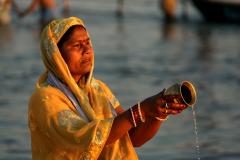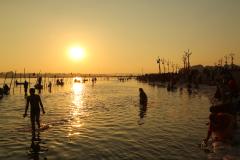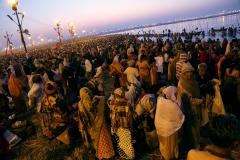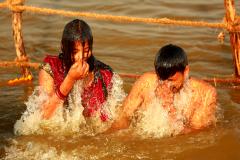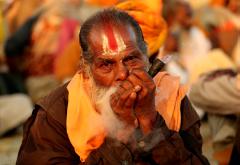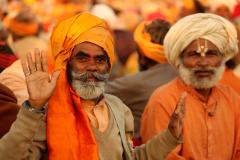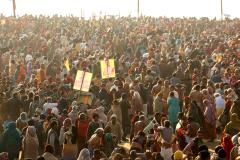Maha Kumbh Mela, take 1
The largest gathering of people on the planet - Maha Kumbh Mela (Great Jar Fair) in Allahabad
Back in the ancient times, gods (devas) started to lose their mighty powers. Vishnu, one of three main Hindu gods, advised them to churn the Ocean of Milk, to obtain Amrita, nectar of immortality. As the gods couldn’t do it one their own, they teamed up with devils (asuras), and by fixing king of nagas (giant snake-like creatures, which typically decorate many Hindu and Buddhist temples) onto Mount Meru, which was used for the churning, they alternatively pulled his head (the demons) and tail (the gods) and together they indeed churned the ocean and gained a full jar of nectar of immortality. But the gods didn’t feel like sharing the immortality and divine powers with the devils, and so they quickly stole the jar and tried to escape. The devils chased them and during the battle for the jar, four drops of nectar spilled onto the earth: in Haridwar, Ujjain, Nasik and Allahabad.
This story, known as Churning the Ocean of Milk is one of the most popular Hindu myths and references to it can be found practically in every temple.
Kumbh Mela – Fair of Jar – is held each 3 years in one of the cities (so each 12 years in each city), but it’s in Allahabad, each 12 years, when Jupiter, the Sun and the Moon align to the rightest position, when it comes the time of Maha Kumbh Mela – Great Fair of Jar – the biggest festival in the world, greatest religious pilgrimage and greatest gathering of people on the planet. Hindu pilgrims come to the confluence of three holiest Indian rivers – Ganga, Yamuna and Saraswati (but don’t look for Saraswati on a map, this river is mythological, it’s the underground river of immortality, that is believed to join Ganga and Yamuna in Allahabad) – to bath in the holy waters, cleanse from their sins and ultimately ensure moksha, liberation from cycle of reincarnations. To reach Nirvana, after they die, to put it short.
Taking one bath, even if the opportunity comes only each 12 years, is surely easier way how to book moksha than by leading spotless spiritual life, so the popularity of the festival is understandable and draws millions and millions of pilgrims.
2013 is year of Maha Kumbh Mela and it’s estimated that around 110 million Hindus will come to Allahabad to take the bath. The festival lasts 1,5 month, but the best day for bathing is 10-Feb-2013, when it’s expected that 40-70 million people will immerse into waters of Ganga/Yamuna in Allahabad.
I found out that this is the year of Maha Kumbh Mela( in the ashram in Rishikesh and decided to take part in it. I knew that just seeing such incredible masses and witnessing the mind blowing scope of the event must be fantastic experience, although obviously, it would be one hell of bone-crushing crowd and I couldn’t imagine, where were all those people going to stay or even how were they going get there. Allahabad has around 1,5 million citizens, and on 10-Feb-2013, there is supposed to be 40-70 million of people around, all racing towards the river for their share of moksha.
I knew that the real thing would be to go there just with a sleeping bag and a mat, but I didn’t have the courage to do this, given the fact that just my photo equipment is worth thousands of EURs and I couldn’t imagine how the event would look like and where would such unimaginable amount of people squeeze in. So I booked a room with one agency, to have a place to lay down without being worried for my camera and stuff and without having to sleeping on (or more probably under) a mountain of Indians.
I arrived on 8-Feb-2013 and I was surprised how smooth the arrival was. I had no booking for the transport from Lucknow, but I knew that trains were all sold out and would be crowded like hell, so I opted for bus, hoping for better chances to actually make it to Allahabad. I headed to Lucknow’s bus station at 5:30 in the morning, and to my surprise, the bus from Lucknow was a direct bus and it was half empty (I took an air conditioned bus, because it was the first bus in the morning and as it was bit more expensive than the normal bus, Indians largely ignored it) and so I had a really comfortable ride to Allahabad and the bus even arrived on time. The traffic chaos around Allahabad was only yet to come. The price of the accommodation included pick-up from the bus station and so, all in all, I got to the camp pretty straightforward (of course that Allahabad itself was already under traffic chaos, but nothing really horrible). So far, so good.
On 8th, in the afternoon, I went to check out, how this place looked like. Well, getting to the right spot (the main bank at the confluence of the rivers) takes 1 – 1,5 hours walking, that is without the crowds. The whole area is GIGANTIC and the area right around the confluence is reserved for ashrams and Indian organizations, so foreigners have to stay relatively far away from the hot spot. I was surprised, that the whole thing seemed to be relatively “well organized”. I mean for India. Any level of organization is already a surprising thing in India. In Europe, we would call it collapse and humanitarian catastrophe, but for Indian standards I would say it was well organized: pontoon bridges across Ganga and Yamuna (which you had to cross to reach the hot spot) were one ways (this alone saved probably thousands of lives and prevented total chaos), there were thousands of policemen and soldiers patrolling the place, the whole area was gigantic as I said, so it could “swallow” really huge crowds and the walking corridors were pretty wide. On the other side, there was virtually no possibility to buy food or water anywhere near the main areas and number of toilets was ridiculously underestimated. There’s maybe 300 hundreds of toilets for few million people. Of course, that this is India, and the usage of the toilet is really not necessary to take shit, but anyway, this place is going to get it BAD. I will not even think about using one of those designated toilets – with 10 000 Indians per day doing their “business” there, I do not want to even imagine how it must look like. As for the water, to buy some, once I was in the main area, I had to walk for one hour to the nearest stall which sold it and then another one hour back :-) Alternative, was to join the Indians and drink the water sprinkling from the pipes, usually right next to a fecal swamp, 1 meter away from those toilet wagons. As for the food, I understood why it was virtually impossible to buy food here – the Indians don’t need it. Every family had brought some rice or flour and a pot with them, and they cooked it on cow shit, straw or wood. These guys are a true lesson in self-reliance! The price of the room included 3 dishes a day in my accommodation, but I would either have to stay there all day or spent 6 hours a day by walking to/from the food to really utilize that option. My camp was also my only chance for civilized toilet.
The things were relatively relaxed here on 8th – the crowds were not so huge yet – people taking bath in the river for spiritual and hygienic reasons, hundreds of sadhus roaming around, in the evening chanting of mantras… The only bothering thing was the police. Give man a whistle and he becomes idiot. It’s so clear in India. Lifeguards in Varkala behaved like idiots just because they had whistles, and the police, well, they are really mentally crippled, turned insane by the “power”, which they were delegated in form of the whistle. They probably think that their whistle is the second most powerful weapon in human history after the nuclear bomb. Or maybe they just like blowing. In any case, they whistle all the time, moving everybody around like if we all were prisoners. It’s also interesting to notice the difference between the soldiers and the policemen. I found it surprising myself, but while all the policemen behaved and looked like real cretins, the soldiers looked and behaved much more intelligent and relaxed. I guess it’s caused by the fact, the policemen is just an “ordinary man” who was suddenly given some power, while being a soldier is more a mission than a job and the training and drill probably makes them more relaxed to operate in conditions like this. But, maybe it’s because the policemen were armed with sticks and whistles and the soldiers with machine guns :-) If I would be given the task to control crowd of 50 million people, then I would be also much more relaxed with a machine gun than with a stick. I mean, I understand that the job of the policemen here is not easy, holding back infinite crowd of Indians, that’s impossible task, so I don’t blame their for higher level of aggression and lower level of patience, but what’s too much is too much.
On 9th I woke up at 3:30, to make it to the hot spot for 4:30, when the bathing starts, to rehearse for 10th, when the BIG thing will happen. Indians really like to make their religious duties in insane morning hours. In Rameshwaram, Madurai, Varanasi, here, everywhere. The busiest ritual time is always 4:00 to 5:30.
9-Feb-2013 was like gathering of a great army. Crowds started coming. By tens of thousands, then by hundreds of thousands and then by millions. Buzz of excitement filled the air. For the first time I could feel, what the generals and soldiers must have felt in the past, when great bodies of army gathered. Say Alexander’s forces, Roman legions or Napoleon’s troops. People just kept on coming and coming. Soon the horizon started to be covered by dust, from all the footsteps of the millions. Police got more aggressive, corridors more full, but everything still relatively peaceful and quiet.
In the evening I saw a gathering of few hundreds of sadhus, all waiting for dinner. And, unlike in Varanasi, where sadhus discovered great business in photography –they happily pose for the pictures but ask money for that – here, they not only did not ask money, all of them were actually asking me to take their pictures and were just as happy about it as the kids in Madurai :-) This was really nice. Some time ago, before coming to India, I decided that I would never ever take pictures if I had to pay for them (I had taken some pictures like this in India 4 years ago…), so this time in India I avoid all money asking sadhus, but here it was finally fun and morally OK to take their pictures. The reason behind unwillingness to pay is not that it would cost too much, 0,1 EUR for a great pictures of sadhus, which I could take everywhere in India, if I would pay them is really not a lot, but it simply makes me sick inside. Paying for posing means artificial, untrue, and I don’t want that kind of pictures. That’s why I don’t ask people to pose. I somehow dislike it, inside. I’m a natural man, I guess :-) I couldn’t be wedding photographer if people would expect those popular theatrical pictures, with idiotic grimaces, which have nothing to do with real life or their real nature. But as said, here the sadhus pose themselves (I never ask them to), many with bongos. By the way, here in Kumbh Mela, possessing and smoking marihuana is legal, because if it was not, they would have to arrest half of the sadhus.
Lots of walking here in Kumbh Mela, at the end of the day I was tired like hell.
